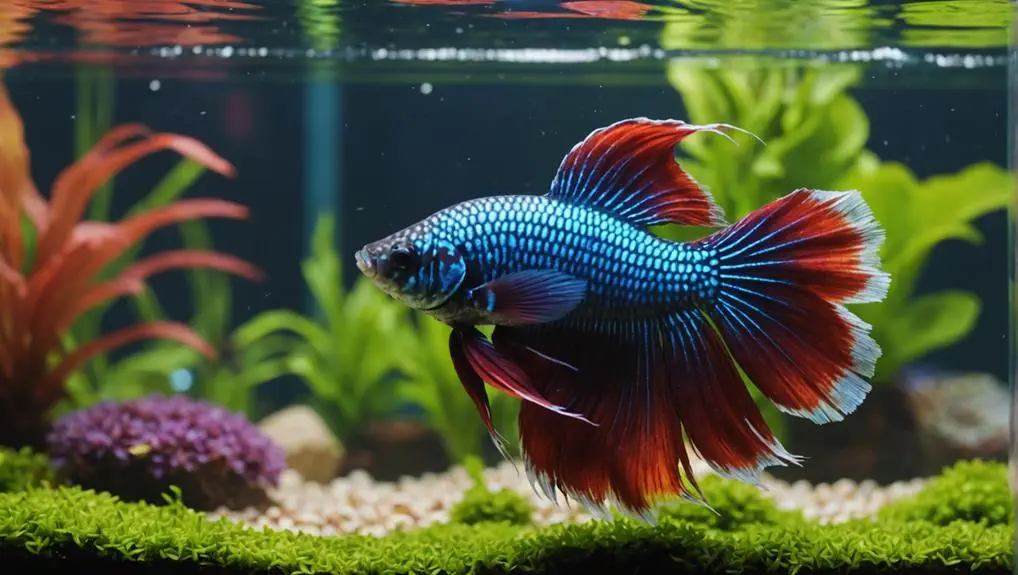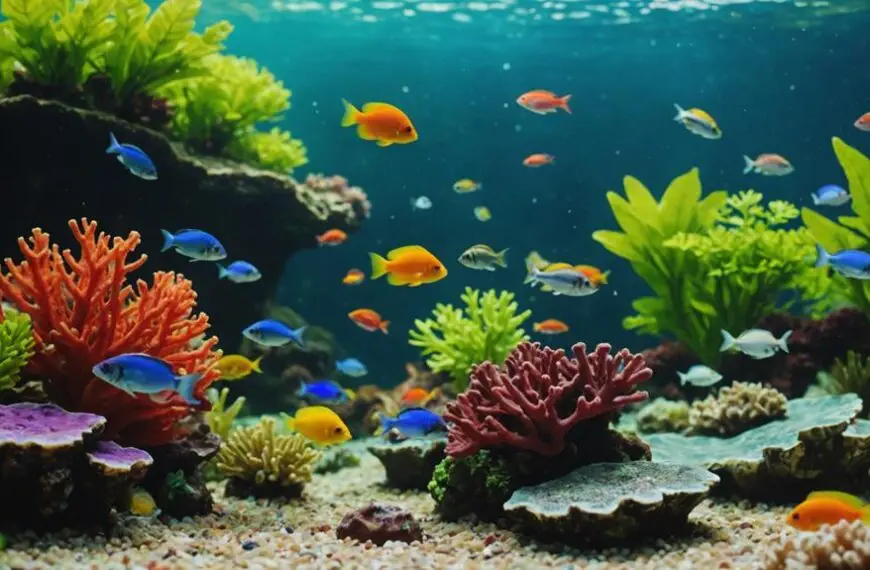Feeding your betta fish properly is essential for keeping it happy and feeling fabulous! Betta fish love a high-protein diet, so you'll want to feed them 4 to 8 high-quality pellets once or twice a day. A little variety goes a long way, too—consider offering frozen treats like bloodworms or brine shrimp once a week. Just be careful not to overfeed; you don't want your fish to have a bloated belly! Make sure to monitor their appetite and give them a fasting day weekly for better digestion. If you're curious about the next steps in their care, there's plenty more to explore!
Contents
Understanding Betta Fish Diet
Understanding Betta Fish Diet is crucial for keeping your fish healthy and vibrant. As a caring fish owner, you want to know exactly what betta fish eat. These little swimmers are carnivores, and they thrive on a high-protein diet.
You should feed your betta fish specially formulated pellets that contain at least 30%-40% crude protein. It's like giving them a gourmet meal every time! Additionally, maintaining optimal water conditions, such as a temperature range of 78-82°F, supports their overall health and appetite, making feeding more effective.
proper tank conditions can significantly enhance your betta's well-being.
But don't stop there! Variety is the spice of life, even for fish. Supplementing their diet with frozen foods like bloodworms and brine shrimp a couple of times a week can keep things exciting. Just imagine your betta's delight as they hunt for these tasty treats!
However, be cautious not to overfeed your betta. It's easy to get carried away, but bloating and constipation are real concerns. A good rule of thumb is to offer about 5-8 pellets once or twice a day.
And don't forget to give them a break once in a while—fasting every 7-10 days can really help with digestion. With just a little effort, you can ensure your betta thrives in its underwater world!
Daily Feeding Recommendations
Feeding your betta fish is a key part of keeping them happy and healthy, so let's get it right!
A well-decorated tank can also enhance their feeding experience by providing engaging environments for exploration and stimulation, which is essential for their mental health natural habitat mimicry.
You'll want to give them about 4 to 8 high-quality pellets once or twice a day, but remember, no one likes to overeat—so a fasting day every week or so can really help.
Keep an eye on their appetite and behavior; a happy betta will be swimming around like it just won a goldfish medal!
Feeding Amount Guidelines
When it comes to keeping your betta fish healthy, getting the feeding amount right is essential. You want to make sure you're feeding your betta the right amount of food to keep them happy and thriving. For adult bettas, aim for about 1.8 grams of food daily, which translates to roughly 4-8 betta pellets. Feeding your betta twice a day is a good routine, so don't hesitate to give them 2-4 pellets during each session.
Remember, bettas have tiny stomachs—about the size of their eye! So, it's crucial to pay attention to any uneaten food after 2-3 minutes and remove it to maintain water quality.
To keep your fish's digestion in check, consider implementing a fasting period of 1-2 days per week. This can prevent constipation and bloating, which are no fun for anyone.
Lastly, keep an eye on your betta's appetite and behavior post-feeding. If they seem uninterested, you might need to adjust the amount of food. After all, a happy betta is a healthy betta, and that's what we all want!
Frequency of Feeding
Establishing a consistent feeding schedule is vital for your betta fish's health and well-being. You should aim to feed your betta 1-2 times daily, offering about 4-8 pellets during each feeding session. This helps your fish anticipate mealtime and creates a routine that promotes happiness.
Remember, a feeding session shouldn't last longer than 2-3 minutes. This keeps your betta from overeating and ensures they nibble on everything you provide.
Don't forget about weekly fasting! Giving your betta a break from food one day every 7-10 days can work wonders for digestion and helps prevent constipation. Just like us, fish can benefit from a little fasting now and then.
Keep an eye on your betta's individual behavior and appetite. If they seem less interested in food, adjust the feeding frequency or portion sizes accordingly. After all, optimal health is the goal here!
Types of Suitable Food
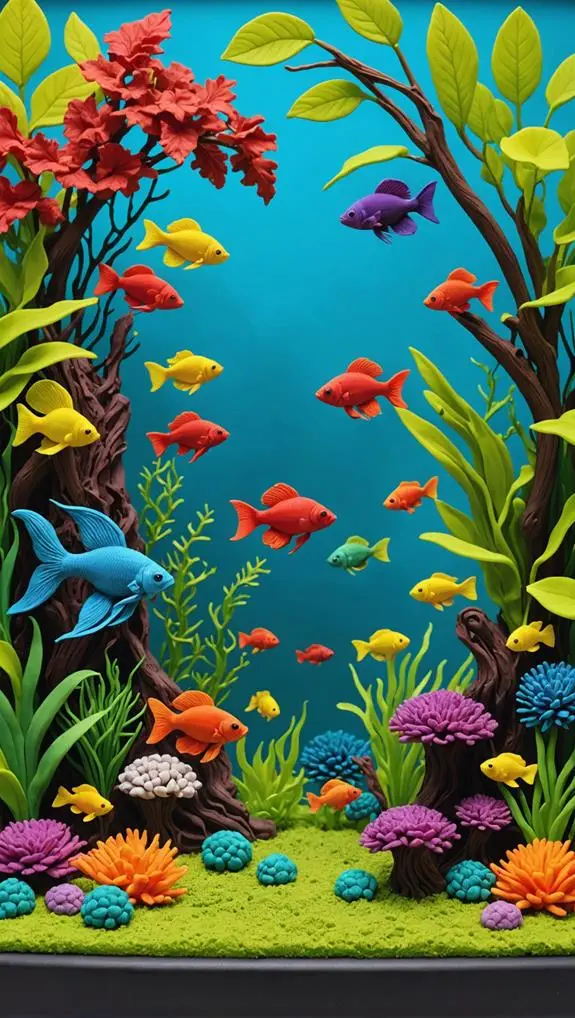
To ensure your Betta fish thrive, it's crucial to provide a high-protein diet tailored to their unique needs. These vibrant little swimmers deserve the best, and feeding them the right foods is key to their health and happiness.
You'll want to focus on high-quality pellets specifically formulated for Betta fish, as they should contain at least 30% protein. Additionally, it's important to maintain optimal tank conditions, as proper tank setup can significantly impact your Betta's overall well-being.
Here's a quick rundown of suitable food options to keep your Betta happy and healthy:
- High-quality pellets: Look for brands like Hikari Betta Bio-Gold or Tetra BettaMin.
- Live food: Bloodworms and brine shrimp can make your Betta do a happy dance!
- Frozen food: Daphnia and other frozen options offer great nutrition.
- Freeze-dried treats: Just remember to soak these in tank water before feeding!
- Avoid flake food: It lacks the protein Betta fish need and can cause tummy troubles.
Feeding Techniques and Practices
Feeding your Betta fish is more than just tossing in some pellets; it's about creating a routine that keeps them healthy and happy. Start by feeding your Betta 2-4 pellets or flakes once or twice daily. The total amount should be roughly the size of their eyeball—no more, no less! This helps prevent overfeeding while ensuring your fish gets a balanced diet.
Consistency is key, so stick to a feeding schedule. Your Betta will appreciate the predictability, making them feel more secure in their habitat.
To add some excitement to their diet, introduce live or frozen foods like bloodworms or brine shrimp once or twice a week. This dietary variety replicates their natural feeding habits and keeps them engaged.
Don't forget to soak any freeze-dried food before serving to enhance its palatability and avoid any tummy troubles!
After feeding, promptly remove any uneaten food to maintain water quality. Keeping the tank clean is essential for a happy Betta.
With these feeding techniques and practices, you're not just feeding a fish; you're nurturing a little aquatic friend!
Signs of Overfeeding
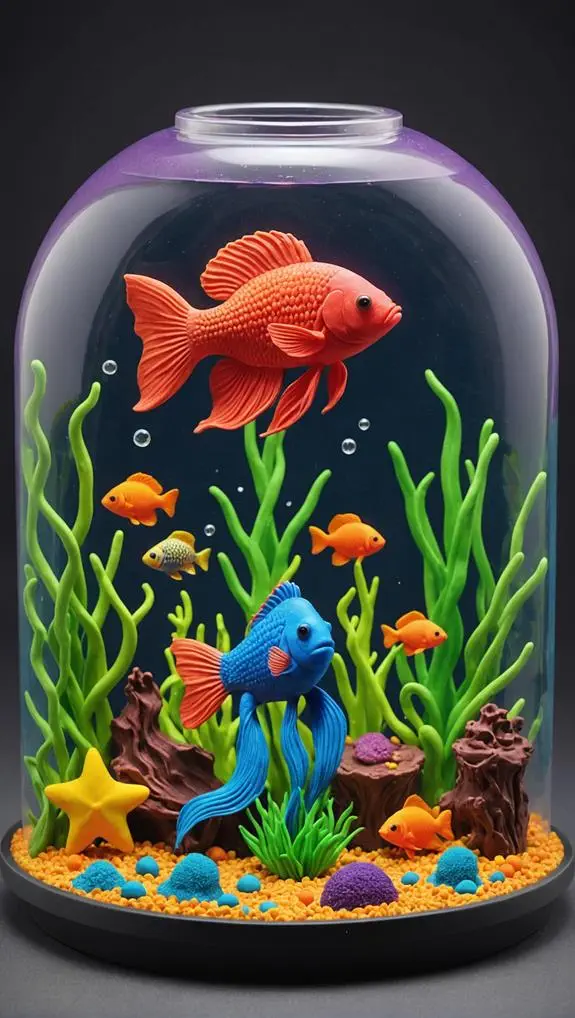
While it's easy to assume that more food means a happier Betta, overfeeding can actually lead to serious health issues. You want your Betta to thrive, so it's crucial to recognize the signs of overfeeding. Here's what to watch for:
- Bloated stomach: A visibly swollen belly is a clear sign of digestive distress.
- Swim bladder issues: If your Betta struggles to swim or floats awkwardly, it might be related to overfeeding.
- Lack of appetite: An overfed Betta may refuse further meals, showing discomfort.
- Poor water quality: Increased waste from overeating can lead to murky tank conditions, affecting your fish's health.
- Uneaten food: Cloudy water caused by leftover food decomposing is a sign you need to clean up for better tank hygiene.
Keeping an eye on these signs can help you maintain your Betta's health.
Remember, it's not just about filling the tank; it's about ensuring a happy and healthy environment for your fishy friend!
Addressing Undereating Issues
If your betta isn't gobbling up their meals, it might be time to play detective. Environmental stressors like water temperature or a cramped tank can throw off their appetite, so make sure their home is comfy.
And if they're still uninterested in food, experimenting with different types of pellets could just spark their interest—after all, who doesn't love a little variety in their diet?
Environmental Stress Factors
Environmental stress factors can greatly affect your betta fish's appetite, leading to undereating issues. To keep your betta happy and eating, it's essential to monitor their environment. Here are some common stressors to consider:
- Water quality: High ammonia or nitrates can stress them out. Clean, well-filtered water is key!
- Tank size: Smaller tanks may feel cramped, causing stress. Aim for at least a 5-gallon tank for more swim space.
- Temperature fluctuations: Bettas prefer stable temperatures between 78-80°F. Sudden changes can make them anxious.
- New surroundings: Changes in tank decor or relocating them can cause anxiety. Give them time to adjust!
- Health issues: If your betta continues to refuse food, it might be a health problem. Consulting an aquatic specialist is wise.
Food Variety Experimentation
To encourage your betta fish to eat more, experimenting with a variety of foods can make all the difference. Bettas are known to be picky eaters, so trying different types of fish food might just spark their interest.
Consider introducing live or frozen foods like bloodworms, brine shrimp, and daphnia once or twice a week. These tasty treats can entice your betta to consume more regularly, improving their overall health.
Don't forget to soak freeze-dried foods before feeding them. This simple step can make them more appealing, especially if your betta seems reluctant to munch on dry pellets.
Changing up the feeding routine or time can also keep them curious and engaged—who doesn't love a surprise meal now and then?
While you're at it, be sure to monitor water temperature. Keeping it between 78-80°F (25.6-26.7°C) is crucial for encouraging your betta's appetite.
With a little creativity and care in their betta fish's diet, you can help your finned friend thrive. So go ahead, mix it up, and watch your little buddy come to life at mealtime!
Health Monitoring Recommendations
Monitoring your betta fish's health is crucial, especially if you notice it's undereating.
While bettas can survive for up to 14 days without food, a lack of appetite can indicate underlying health issues that need your attention.
It's essential to keep an eye on your fish's behavior and feeding habits to catch any problems early on.
Here are some recommendations:
- Check water conditions: Ensure the temperature and cleanliness of the tank are optimal.
- Observe behavior: Look for signs of stress or lethargy; these can affect appetite.
- Experiment with food: Try different high-quality pellets or even live food to entice your betta.
- Monitor feeding: Keep track of how much food your betta eats daily.
- Consult a vet: If your betta consistently refuses food, it's time to get professional advice.
Cultivating Live Food
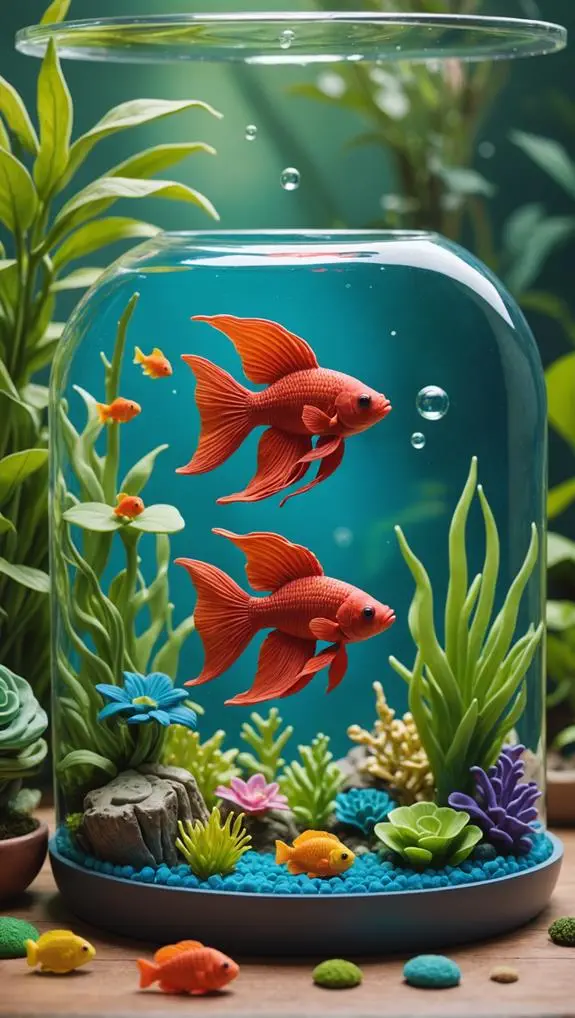
Cultivating live food for your betta fish can be a rewarding and beneficial endeavor. By growing nutritious varieties like bloodworms, daphnia, and brine shrimp, you're not just feeding your fish; you're also enhancing their health and happiness!
Bloodworms thrive in stagnant, shaded water with organic debris, and you can harvest them in just 2-3 weeks. Just remember to use de-chlorinated water and some dead leaves to get started.
For daphnia, all you need to do is add eggs to de-chlorinated water, letting it sit for a couple of days. Regular water changes every 2-3 weeks will help keep your daphnia population healthy.
Brine shrimp are another fantastic option. They love aerated setups with aquarium salt, hatching within 12-48 hours when conditions are right.
While you're cultivating these live foods, don't forget to monitor water quality! Keeping an eye on it helps prevent disease risks when feeding bettas.
Your fish will appreciate the effort, and you'll feel great knowing you're providing a fresh meal. Plus, who wouldn't want to be the proud chef of a mini aquatic buffet?
Cost Considerations for Feeding
Feeding your betta fish can be budget-friendly if you plan wisely.
With a bit of smart shopping, you can keep your fish happy without breaking the bank. Here are some cost-saving options to consider for their feeding:
- Pellets: Prices range from $4 to $8 per container, making them an affordable staple for your betta fish.
- Freeze-dried foods: These vary in cost, but some brands offer bulk purchasing options to help you save in the long run.
- Bulk buying: Purchasing food in larger quantities often leads to better deals, ensuring you have enough for regular feeding.
- Healthier diets: While species-specific diets may cost more upfront, they provide better nutrition, making it worth the investment.
- Budget planning: Consistent budgeting helps you maintain access to quality food and supplies needed for your betta's health.
Frequently Asked Questions
How Much Should I Feed My Betta Fish Daily?
You should feed your betta fish daily with high-quality pellets, matching their nutritional needs. Observe feeding habits for overfeeding signs, and maintain a consistent feeding schedule, adjusting for diet variations and frequency as needed.
What Are the Feeding Instructions for Betta Fish?
Imagine your betta, vibrant and energetic. For optimal health, feed them 2-4 pellets daily, about their eyeball's size. Mix in live food weekly, adjusting feeding frequency based on their nutritional needs and preferences.
How Do I Know if I'm Feeding My Betta Enough?
To ensure you're feeding your betta enough, watch for betta feeding signs like a round belly. Monitor betta health indicators, adjust proper portion sizes, and vary food types to enhance their diet and satisfy appetite.
How Many 1 Mm Pellets to Feed Betta?
For optimal health, feed your betta 4-6 high-quality 1 mm pellets daily. Observe feeding behavior and adjust your feeding schedule based on water temperature, ensuring dietary variety while watching for overfeeding signs.
Final Thoughts
So, there you have it! Feeding your betta fish might seem like a piece of cake, but remember, it's not just about tossing in some flakes and calling it a day. With the right food and careful attention, you can ensure your little swimmer stays happy and healthy. And if you ever find yourself tempted to overfeed, just think—your betta's not training for a fishy marathon! Keep it balanced, and you'll both swim happily ever after.

